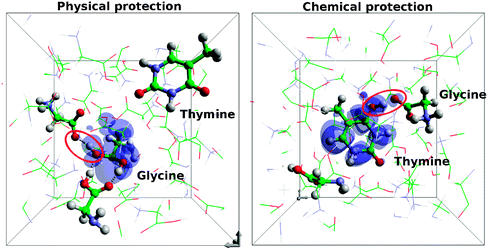Using first-principles molecular dynamics simulations, we have investigated the notion that amino acids can play a protective role when DNA is exposed to excess electrons produced by ionizing radiation. In this study we focus on the interaction of glycine with the DNA nucleobase thymine. We studied thymine–glycine dimers and a condensed phase model consisting of one thymine molecule solvated in amorphous glycine. Our results show that the amino acid acts as a protective agent for the nucleobase in two ways. If the excess electron is initially captured by the thymine, then a proton is transferred in a barrier-less way from a neighboring hydrogen-bonded glycine. This stabilizes the excess electron by reducing the net partial charge on the thymine. In the second mechanism the excess electron is captured by a glycine, which acts as a electron scavenger that prevents electron localization in DNA. Both these mechanisms introduce obstacles to further reactions of the excess electron within a DNA strand, e.g. by raising the free energy barrier associated with strand breaks.
